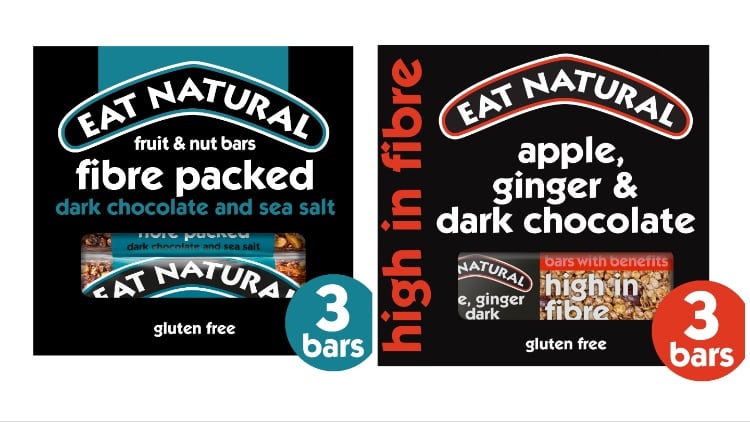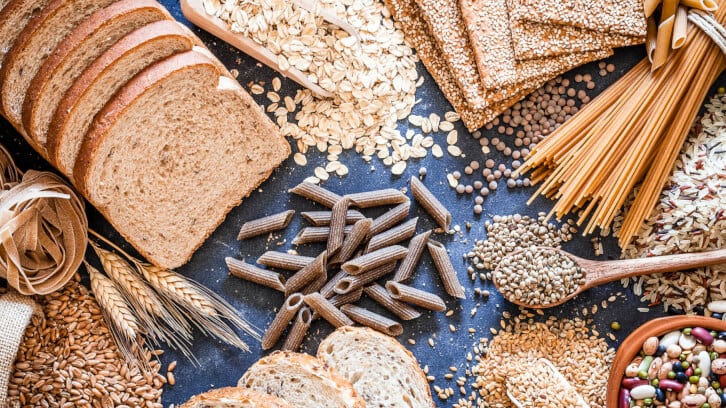This month marks Fibre February, an annual campaign which aims to drive awareness of the UK’s absence of fibre in their diets.
While adults are reportedly eating less than 20g of their recommended daily fibre intake, research finds that no age group is getting sufficient fibre.
Fibre is good for you, but consumers just aren’t aware
However, fibre plays a crucial role in digestion and can support overall wellness goals. In fact, according to the Global Burden of Disease report, poor diets contribute to 11 million deaths worldwide, with more than 600,000 deaths directly related to low fibre diets.
As Dr Stacey Lockyer, BSc(hons) MSc PhD RNutr, senior nutrition scientist at the British Nutrition Foundation, explains: “Fibre helps to keep our gut healthy and can help reduce constipation. A high fibre diet may help to reduce our risk of heart disease and stroke, type 2 diabetes, and colorectal cancer.”
According to data from the FDF, only 1 in 3 people know that the recommended amount of fibre adults should consume is 30g. Beyond that, approximately 70% of people are unaware if they meet that recommended amount, with statistics from FAB Flour revealing that as many as 75% of women and 50% of men need to increase their fibre consumption.

Research from General Mills (in its ‘Going Against The Grain’ report) echoes these findings. In a survey it conducted, it found that while most people (74%) claimed to know what dietary fibre is, only a third (36%) were able to pick out the correct definition from a list, namely, ‘a type of carbohydrate that humans can’t digest’.
Speaking with Food Manufacture, a spokesperson from General Mills also noted the unhelpful absence of fibre on labelling: “Fibre is not consistently labelled on food products and is therefore not always available for consumers.”
They added: “As well as lack of awareness, an ardent lack of interest is apparent. Fibre often takes a backseat when it comes to shopping for food, and consumers’ minds are perhaps more occupied by the louder messaging on reducing sugar, fat and salt consumption. Just 22.7% of the Brits surveyed consider high-fibre foods as their go-to options, indicating a lack of prioritisation of fibre-rich foods in their diets.”
Could fibre help the UK obesity crisis?
Alongside its health bonuses, there is also research to suggest that fibre could help with weight loss. With the UK in the grip of an obesity crisis, plugging the fibre gap could therefore be a very prudent course of action for Government to push.
Soluble fibre, in particular, slows stomach emptying, increases perceived satiety and significantly impacts appetite regulation.
Another benefit of soluble fibre, as raised in the General Mills report, is that it is fermented by ‘good’ bacteria living in the colon. These go on to release short chain fatty acids – known to regulate the actions of hormones which boost feelings of fullness and reduce appetite.
But for all its perks, the fibre gap is widening; with the Government’s most recent National Diet and Nutrition Survey finding that adults’ already low fibre intake plummeted by more than 2g a day following the pandemic.
How to boost fibre
When it comes to boosting dietary fibre, priority should be given to foods such as wholegrain breakfasts, brown rice, pasta, skin on potatoes and wholegrain bread.
“Using wholegrains in recipes remains one of the most effective ways of adding fibre to baked goods,” added Julie Telfer, who is the NPD manager at Northumberland-based Silvery Tweed, which supplies many leading names in cereal and baking across the UK and Europe. “Grains such as the barley, wheat and rye we process every day are a great source of naturally occurring fibre, especially in their wholegrain form whether flaked, kibbled or milled to flour.”
But as Telfer went onto say, wholegrains don’t just add fibre, they can also be used to enhance flavour and texture, as well as acting as an interesting visual element in foods like bread.
“At Silvery Tweed, we help customers create simple, high-fibre bakery blends that combine wholegrain products that are naturally high in fibre. We can also add fibres, such as chicory root fibre and acacia fibre, to help achieve high fibre claims.”
Incorporating seeds and pulses is another way of increasing fibre claims in bakery products, as Telfer elaborated: “These tiny superfoods pack a real fibre punch and a little can go a long way in increasing daily fibre intake.
“Seeds such are brown and golden linseed, sunflower, pumpkin, poppy and chia seeds are all popularly used. Chia seeds are a particular heavyweight, with one tablespoon delivering 5g of fibre. We also add pulses such as peas, beans, lentils, and chickpeas to baked goods for their protein content as well as to boost fibre levels.”
ADM Milling has also been developing new lines of wholegrain and high-fibre flour breads.
“Emerging in the marketplace are the development of grains with high levels of naturally occurring fibre,” commented ADM Milling’s marketing executive, Laura Passingham. “We recently introduced our multiseed concentrate to our pantry of flours, mixes and sundries.
Multiseed concentrate includes a blend of premium wheat with a variety of seeds and ingredients, including sunflower seeds, pumpkin seeds, linseeds, wheat bran and oats.
“These ingredients not only contribute to the taste and texture of baked goods, but also increase the overall fibre content,” Passingham explained.
“We can elevate the sensory attributes and illustrate the benefits of fibre through our high-fibre baking concepts, including a high-bran loaf, Swedish high-fibre bread, wholemeal and rye breads, wholemeal crusty bread, wholemeal Multiseed rolls and more.”
Passingham added that as consumers seek greater control of their health, many are also keen to explore gut microbiome-supporting solutions, which includes prebiotic dietary fibre.
“ADM/Matsutani LLC’s Fibersol®, an innovative soluble prebiotic dietary fibre, can further support the desire for more added fibre,” she highlighted.
“Backed by over 30 years of research, Fibersol® is shown to be well-tolerated at up to 68 grams per day. It also ferments more slowly in the large intestine, leading to less gastric discomfort compared to fibres that ferment quicker.”1,2
Clinical studies also show that Fibersol® promotes the growth of gut microbes which have been positively associated with health. A clinical study has also shown that Fibersol® may help nourish the intestinal flora and maintain a healthy intestinal tract environment (at 3.75 grams per serving).3-5
Despite a fibre gap, consumers want function
Although there is a big fibre gap in the UK, consumers are becoming more mindful of their health and Eat Natural – a snacking brand under the Ferrero umbrella – told Food Manufacture it thinks we’ll likely see consumers becoming more informed of the benefit of fibre too.
“We know that today’s consumers have a greater understanding of what they like. They are also more aware of what they consume affects their health,” said the Eat Natural representative.
“Consumers expectations in snacks have over recent years expanded beyond the taste experience. Not only are they looking for their snacks to be great tasting but also to provide them with functional benefits.”
As the spokesperson at Eat Natural acknowledged, the rise in health and well-being trends has given way to new opportunities in NPD, including snacking foods with fibre claims.

To this end, Eat Natural has created two fibre-geared products that call out their high fibre content. The first, its ‘Fibre Packed Dark Chocolate & Sea Salt’ bars, and the second, its ‘High in Fibre Apple, Ginger & Dark Chocolate’ bars.
Fellow snacking brand Fibre One, owned by General Mills, has also been innovating in this space.
"The Fibre One 90 Calorie is one of the UK’s number one diet management brands, with £25m sales value and a 3.2% value share," a spokesperson for the brand told Food Manufacture.
“The products in the range are permissibly indulgent snacks with a high fibre content per product,” they added. “Intent on continually meeting consumer needs with new innovations, we recently expanded the Fibre One 90 Calorie range with the launch of two, non-HFSS SKUs available in major grocers in the UK: Crispy Choc Squares and reformulated fan favourite Cookies and Cream Drizzle Squares.
“Both SKUs contain 50% less sugar and are HFSS compliant, so our retailer partners are free to promote the products in store.”
General Mills has also introduced a brand-new addition (Banoffee Flavour) to its range of permissible doughnuts, which is growing in value YoY by 42.9%, with 3.2m sales value, late last year.
Fixing the fibre gap
Along with new product launches, the food sector is also engaging in campaigns like that of the aforementioned ‘Fibre February’, as well as other industry-wide initiatives like ‘Action on Fibre’.
Action on Fibre was launched by the FDF in 2021 and is said to have helped deliver 7.2bn more servings of fibre to the population.
While these campaigns are making a dent, it’s evident further measures are needed.
Commenting on what both government and industry can do, the spokesperson from General Mills said: “Initially, education is paramount. Government bodies can launch educational campaigns that highlight the diverse benefits of fibre, its role in digestive health, weight management, and disease prevention.
“A real challenge for consumers is knowing where to find the best sources of fibre, so the wider food industry should seek to ensure that information about fibre is labelled clearly and effectively. Increasing the offering of products that are a good source of fibre, as well as incorporating them into promotional campaigns and discounts can also help to promote awareness."
They concluded: “A great case study to reference here is the Danish Whole Grain Partnership, established in 2008, designed to make it easier for consumers to eat more whole grains. As a result, the intake of whole grain in the Danish population increased from an average of 36g (2007) to 82g a day (2019) and the availability of whole grain products and knowledge of the health benefits of whole grain have increased, demonstrating the true, vast impact of a public-private partnership.”
References
- Kishimoto, Y.; et al. (2013). J. Nutr. Sci. Vitaminol (Tokyo) 59(4):352-7
- Flickinger, EA; et al. (2000) J Nutr. 130(5): 1267-1273
- Mai, V. (2012). Clin Microbiol Infect, 18(Suppl. 4), 62-66
- Burns, A. (2018). Nutrition Research, 60, 33-42
- Mai, V.; et al. (2022) Nutrients. 14(11):2192
In other news, Wensleydale Creamery has made a big investment into a new cheese smoke house.





